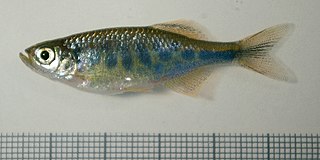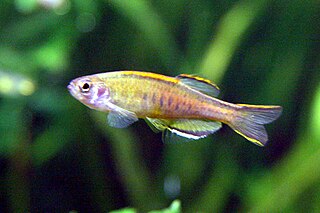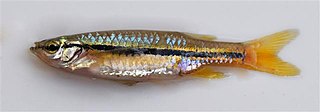
The giant danio is a tropical fish belonging to the minnow family Cyprinidae. Originating in Sri Lanka, Nepal, and the west coast of India, this species grows to a maximum length of 4-6 inches (10-15 cm), making it one of the largest of the danionins. It is characterized by a blue and yellow, torpedo-shaped body with gray and clear fins.

Devario is a genus of fish in the family Cyprinidae native to the rivers and streams of South and Southeast Asia. These fishes have short barbels and many species having vertical or horizontal stripes. These species consume various small, aquatic insects, crustaceans and worms, as well as, in the case of fry, plankton.

The glowlight danio is a small, schooling fish closely related to the popular zebrafish Danio rerio. This should not be confused with the GloFish, a trademarked brand of fluorescent zebrafish that appear to glow in the dark under ultraviolet light. Danio choprae is an active danionin species that spends most of its time on mid-water levels. This species feeds on insects that have fallen into the water, aquatic insect larvae, and other small animals. In the aquarium, it accepts most foods offered, including most dry foods. It has a streamlined body marked with a brilliant orange longitudinal band and a series of vertical blue-black bars on the flanks. The fins are edged with yellow. In recent years, it has become quite widely traded as an aquarium fish, but otherwise has no commercial importance. Its common name derives from its similarity to the glowlight tetra, a South American characin only distantly related to this fish. They get on well with all other Danio species except the giant danio.

The term coldwater fish can have different meanings in different contexts.

Danio is a genus of small freshwater fish in the family Cyprinidae found in South and Southeast Asia, commonly kept in aquaria. They are generally characterised by a pattern of horizontal stripes, rows of spots or vertical bars. Some species have two pairs of long barbels. Species of this genus consume various small aquatic insects, crustaceans and worms.
The Burma zebra danio or KP01 danio is a tropical fish belonging to the minnow family (Cyprinidae). It is believed to originate in Myanmar. This fish was discovered in 2006 and is believed to be a separate species from the zebra danio to which it has a close resemblance. However, it is more likely to be closely related to the Yoma danio, and is believed to be a similar size, 6–9 cm, to the latter.

The Indian flying barb, historically flying barb, is one of the species known in the group flying barbs owing to their extremely long barbels. It was discovered as long ago as 1822 by Hamilton. However, it is rarely seen in aquaria. It is found in Myanmar, Nepal, Pakistan, Sri Lanka and India, it is found in many of the same localities as Danio rerio and Danio dangila, an example being the Jorai Rivulet, a tributary of the Sankosh river in Coochbehar district, West Bengal, India. The rare fish Borellius spp. is locally named "Boirali maach". In Nepalese Terai it is called Dedhawa.

Microdevario kubotai is a species of cyprinid found in southeast Asian rivers and streams. It belongs to the genus Microdevario, which contains small danionins. The type locality is in Ranong Province, Peninsular Thailand. It is also known from the adjacent Phang Nga Province and the Ataran basin in Myanmar. It likely occurs elsewhere in the region and an introduced population exists in the Songgaria River. It reaches up to 1.9 cm (0.75 in) in length,the maximum length can reach 2.5 cm (0.98 in).

Danio margaritatus, the celestial pearl danio, often referred to in the aquarium trade as galaxy rasbora or Microrasbora sp. 'Galaxy', is a small cyprinid from Myanmar and Northern Thailand. It has so far been found only in a very small area near Hopong east of Inle Lake, at an elevation of over 1,000 m (3,400 ft). Its habitat is part of the Salween basin, namely the Nam Lang and Nam Pawn Rivers. Discovered in 2006, the species quickly appeared in the aquarium trade, where its small size and bright colours made it an instant hit.

The danionins are a group of small, minnow-type fish belonging to the family Cyprinidae. Species of this group are in the genera clades danio and devario, based on the latest phylo-genetic research by Fang et al in 2009. They are primarily native to the fresh waters of South and Southeast Asia, with fewer species in Africa. Many species are brightly coloured and are available as aquarium fish worldwide. Fishes of the danio clade tend to have horizontal stripes, rows of spots, or vertical bars, and often have long barbels. Species within the devario dlade tend to have vertical or horizontal bars, and short, rudimentary barbels, if present at all. All danionins are egg scatterers, and breed in the rainy season in the wild. They are carnivores, living on insects and small crustaceans.
Fang Fang Kullander, née Fang Fang, was a Swedish-Chinese ichthyologist.